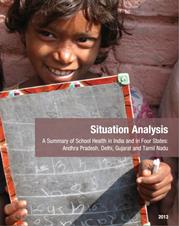
Infectious diseases contribute to 60% of all school aged child deaths in India, more than half of these are directly due to diarrhoeal diseases and pneumonia, and girls are disproportionately affected.
This was one finding from the recently released
Partnership for Child Development (PCD), Imperial College London “
Situation Analysis A Summary of School Health in India and in Four States”, which identifies best practice, challenges and opportunities in Indian school health programmes to help catalyse achieving Education for All (EFA) and health development goals.
With a growing population of 192 million school-age children in India, advancing progress towards MDGs on education and health therefore stands to benefit almost one-fifth of India’s overall population.
“A political and financial commitment to School Health and Nutrition (SHN) programmes in India, particularly at the national level would see huge improvements to child health and education, improving the lives of millions of Indian school-aged children,” said PCD’s Executive Director, Lesley Drake. She continued,
“This commitment would ensure minimum standards of school-based health services, safe environments, inclusion and education are provided across all of India’s states.”
The Situation Analysis focused on the four states of Andhra Pradesh, Delhi, Gujarat and Tamil Nadu outlines that despite a number of child health and development policies in place to varying extents in the states, the SHN response remains largely health-led and health service, it recommends that with increased involvement of the education sector, full gains in child health and education could be achieved.
In recent years, cost-effective and sustainable initiatives such as SHN programmes which support child health and well-being and encourage children to be fit to learn are now widely recognised as a catalyst for achieving EFA and have gained attention as effective means of “levelling the playing field” for all children, with particularly notable benefits for the most vulnerable and poorest children, thereby working to address disparities. Such interventions include school feeding, WASH promotion and HIV/AIDS, malaria and parasitic worm prevention.
Alongside other recommendations, the analysis highlights that improving the evidence base and putting evidence into action could be furthered, in addition to multisectoral collaboration, human resource mobilisation and improved teacher and health provider training to use the teaching workforce as low-cost champions for basic child health.

